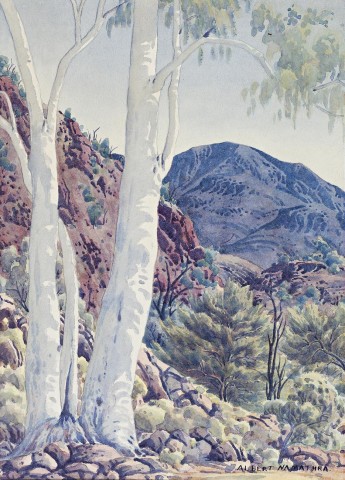GHOST GUMS, MACDONNELL RANGE, c.1947
ALBERT NAMATJIRA
watercolour on card
36.5 x 26.5 cm
signed lower right: ALBERT NAMATJIRA
bears inscription on old backing board verso: 35 / Ghost Gums, Macdonald [sic] Range / 23
Mary Corkery Artists’ Agent, Brisbane (receipt attached verso)
Private collection, Melbourne, acquired from the above in 1947
Thence by descent
Private collection, Toronto
Albert Namatjira: Watercolours of Central Australia, Commercial Bank Chambers, Brisbane, 4 – 8 November 1947, cat. 23
Ghost Gum, Central Australia, c.1945 in the collection of the National Gallery of Victoria, Melbourne, illus. in French, A., Seeing the Centre: The Art of Albert Namatjira, 1902-1959, National Gallery of Australia, Canberra, 2002, p. 117
Ghost Gum, c.1948, in the collection of the National Gallery of Australia, Canberra, illus. in French, A., Seeing the Centre: The Art of Albert Namatjira, 1902-1959, National Gallery of Australia, Canberra, 2002, pp. 116, 124
'He was definitely the beginning of a recognition of Aboriginal people by white Australia'.1
Albert Namatjira was already an accomplished craftsman producing pokerwork decorated woomeras, boomerangs and wooden plaques when Victorian artists Rex Battarbee and John Gardner held an exhibition of watercolour paintings at the Hermannsburg Mission in 1934. Namatjira’s immediate interest in the medium and his skilful implementing of the techniques and materials of western landscape painting set off an artistic career that spanned a quarter of a century and elevated Namatjira to a household name across Australia.
Namatjira’s painting of the central Australian landscape was both innovative and personal. However, contained within the cover of the western artform, the artist also made claim to his country, plural meanings can be seen to have existed within his paintings. A landscape sight can also be read as memory of an ancestral site and through the reiteration of subject, a claim of ownership could be made. Gum trees and mountains feature prominently in Namatjira’s work and Ghost Gums, Macdonnell Range, c.1947 is a prominent example of both a familiar subject to the viewer and a statement of belonging by the artist.
As with many of Namatjira’s paintings, the towering ghost gum dominating the foreground is clearly the subject of this work. The white gum of two or three trunks to the left of the picture, provides the key to the pictorial organization, playing a pivotal role as both a device for opening and framing the picture plane. The distant mountain range contained within the trunk and branches of the tree is viewed past the sloping hill in the middle ground, each chronicled in harmonious red and purple tones and separated by small valleys populated with olive foliaged trees with black trunks. The distant view is a stark contrast to the whiteness and solid strength of the Ghost Gum which is both the paintings focus and the pointer to a far off landscape. An incredibly hardy species, the Ghost Gum (Eucalyptus papuana), known as ilwempe to the Western Arrernte, grows in extraordinary inhospitable conditions. It features in Aboriginal creation stories where individual trees can be considered to represent ancestral beings.2
The art of Albert Namatjira can be seen to have inspired his own and subsequent generations of Aboriginal people and artists across Australia. Brenda Croft argues that the Artist’s gift to indigenous and non-indigenous people is ‘more than the sum parts of watercolour paints on paper. It is an essence that resides in the strength of Namatjira’s work – his courage, his sorrow, his spirituality… where the enduring influence of this one man upon the entire indigenous arts and culture industry continues to be felt’.3
1. Charles Perkins, quoted on the 7.30 Report: McLaughlin, M., 'A Report on the Life of Albert Namatjira', 7.30 Report, Australian Broadcasting Corporation (ABC), broadcast 3 July 2002
2. French, A., Seeing the Centre: The Art of Albert Namatjira, 1902-1959, National Gallery of Australia, Canberra, 2002, p. 121
3. Croft, B., ‘Albert’s Gift’ in French, A., Seeing the Centre: The Art of Albert Namatjira, 1902-1959, National Gallery of Australia, Canberra, 2002, p. 148
CRISPIN GUTTERIDGE
